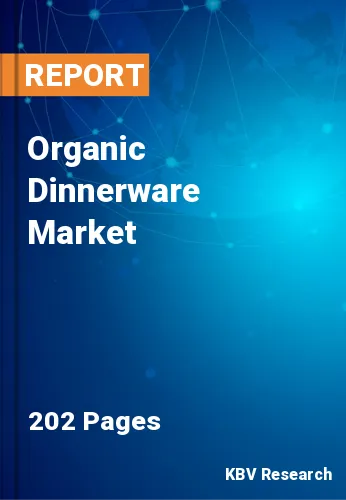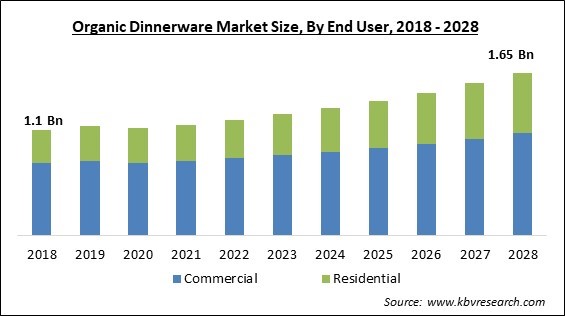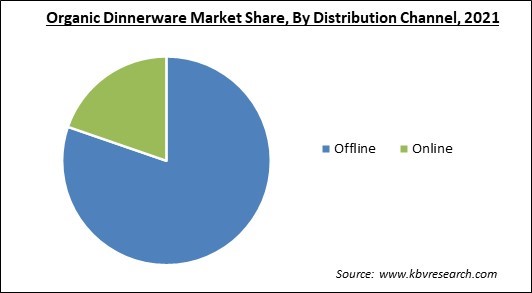
The Global Organic Dinnerware Market size is expected to reach $1.65 billion by 2028, rising at a market growth of 5.8% CAGR during the forecast period.
Dinnerware is a crucial component for presenting food in a graceful and delectable manner, especially in high-end restaurants and hotels. It not only complements the delectable food on the table but also improves the whole ambiance of the establishment where the consumer is dining. People nowadays are eager to purchase exceptional dinnerware for their respective homes, as well as to cherish and provide a lavish experience to themselves and their guests in the case of family gatherings, house parties, meetings, or other similar get-togethers, as it denotes class and says a lot about the person presenting it.

Market participants have already been forced to adopt new techniques for enticing clients as a result of the rise of organic tableware. For instance, in May 2021, West Elm, a global design firm based in the United States, announced a collaboration with Heather Taylor, a Los Angeles-based designer. The major purpose of this partnership is to offer 100 one-of-a-kind items, including original or modern dinnerware. In the analysis timeframe, these types of actions from market leaders are likely to drive the organic dinnerware market share. Because the majority of dinnerware on the market today is comprised of plastics, organic tableware is rising in favor. Plastic tableware is made from fossil fuels, which is not an environmentally friendly material.
As a result, trash disposal concerns arise, as the plastic garbage ends up in landfills, polluting the environment. In the future years, these factors are expected to have a beneficial impact on market share. Organic tableware has a number of advantages, including the ability to make low-waste products with either zero waste or much less trash than conventional options. Furthermore, these goods are biodegradable, meaning they can be readily composted and do not pollute the environment.
People at home, on the other hand, have begun to focus more on cooking and house repairs, as well as internet shopping, which may enhance the demand for organic dinnerware. Furthermore, the reopening of malls, HoReCa (Hotels, Restaurants, Cafés), and supermarkets are supporting merchants and other value chain actors in resuming operations. Several enterprises have turned to internet business and e-commerce to stay afloat during the current COVID-19 outbreak. Because of the low purchasing power of consumers, brands offer bargains, discounts, and other tempting incentives to their customers. Furthermore, certain significant players in the organic dinnerware industry are anticipating a positive outcome following the pandemic.
Organic dinnerware is produced from bamboos, birch woods, fallen areca palm leaves, banana leaves, sugarcane bagasse, and other eco-friendly materials. These things' products are entirely biodegradable, compostable, and environmentally safe, and they pose no health risks to people. Furthermore, organic tableware is sufficiently strong and sturdy to endure knives or other metal utensils, whereas plastic or Styrofoam plates would not. Furthermore, because some organic dinnerware is incredibly convenient to use and some are simply disposable, it significantly minimizes the overall handling and cleaning effort, allowing users to relieve themselves of the job of doing the dishes in the event of large gatherings or house parties.
Organic tableware is extremely heat resistant and can endure temperatures of up to 300 degrees Fahrenheit without producing any toxic chemicals, making it completely microwave safe. Furthermore, organic dinnerware is incredibly cost-effective, making it excellent for small-scale eateries and individuals on a tight budget. The issue with plastic is that it is not all created equal. The term "plastic" refers to a variety of materials that have been shaped or stabilized with the addition of chemicals. Bisphenol A or BPA (used to make plastics tougher) and phthalates (used to make plastic stronger and more flexible) are the two most used stabilizers.

The fast food industry is on the rise across the world due to the convenience they provide. Consumers can get their food in a short amount of time rather than waiting for long, such as in a restaurant. Both international fast-food chains and small fast-food stalls use disposable plastic plates, bowls, and cutlery to cut costs. Because of their elegance, most ceramic products are pricey. Their material is of exceptional quality. Ceramics production necessitates a high level of skill and knowledge. People who make ceramic design products are well trained and hence the labor cost is high as well. The use of disposable plates, bowls, and cutlery in many small eateries can limit the market expansion of organic dinnerware in the commercial sector due to their low cost and lack of upkeep.
Based on End User, the market is segmented into Commercial and Residential. The commercial segment acquired the highest revenue share in the organic dinnerware market in 2021. The rising demand for organic dinnerware in commercial sectors such as hotels, restaurants, and others in emerging nations is expected to drive this rise, as individuals adopt organic products for dining and serving. Furthermore, the present generation's increased interest in hotels and restaurants may lead to an increase in the use of organic tableware.
Based on Distribution Channel, the market is segmented into Offline and Online. The online segment received a major boost after the pandemic. Due to the fear of catching the covid-19 virus, many people turned to e-commerce websites to meet all their shopping needs. Even organic dinnerware brands increased their marketing and accessibility on these platforms. Many e-commerce sites offer deals and discounts to bring consumers.
Based on Product, the market is segmented into Plates, Bowl Sets, Cup Sets, and Others. The plate segment acquired the highest revenue share in the organic dinnerware market in 2021. The popularity of the plates segment can be ascribed to its market expansion in the hospitality sector. Furthermore, rising eco-friendly or organic plate trends are some of the reasons that could propel the organic dinnerware market forward.
| Report Attribute | Details |
|---|---|
| Market size value in 2021 | USD 1.1 Billion |
| Market size forecast in 2028 | USD 1.65 Billion |
| Base Year | 2021 |
| Historical Period | 2018 to 2020 |
| Forecast Period | 2022 to 2028 |
| Revenue Growth Rate | CAGR of 5.8% from 2022 to 2028 |
| Number of Pages | 205 |
| Number of Tables | 239 |
| Report coverage | Market Trends, Revenue Estimation and Forecast, Segmentation Analysis, Regional and Country Breakdown, Companies Strategic Developments, Company Profiling |
| Segments covered | Product, Distribution Channel, End User, Region |
| Country scope | US, Canada, Mexico, Germany, UK, France, Russia, Spain, Italy, China, Japan, India, South Korea, Singapore, Malaysia, Brazil, Argentina, UAE, Saudi Arabia, South Africa, Nigeria |
| Growth Drivers |
|
| Restraints |
|
Based on Regions, the market is segmented into North America, Europe, Asia Pacific, and Latin America, Middle East & Africa. Europe procured a significant revenue share in the organic dinnerware market in 2021. In Germany, the demand for tableware is being driven by rising urbanization and increased spending on home design. The tourism and hospitality sector of the region is very developed and draws in consumers from the across the world.
Free Valuable Insights: Global Organic Dinnerware Market size to reach USD 1.65 Billion by 2028
The market research report covers the analysis of key stake holders of the market. Key companies profiled in the report include Hermes International S.A., Portmeirion Group Limited (Royal Worcester), Lenox Corporation, Royal Doulton (Fiskars Group), Guy Degrenne, Corelle Brands LLC (Instant Brands Inc.), Libbey Glass LLC, Herend porcelain manufactory ltd., and Porzellan-Manufaktur Meissen GmbH.
By End User
By Distribution Channel
By Product
By Geography
The global organic dinnerware market size is expected to reach $1.65 billion by 2028.
Organic Dinnerware is Environmentally Friendly are driving the market in coming years, however, Use of Plastic Cutlery in Fast Food Restaurants limited the growth of the market.
Hermes International S.A., Portmeirion Group Limited (Royal Worcester), Lenox Corporation, Royal Doulton (Fiskars Group), Guy Degrenne, Corelle Brands LLC (Instant Brands Inc.), Libbey Glass LLC, Herend porcelain manufactory ltd., and Porzellan-Manufaktur Meissen GmbH.
Certain significant players in the organic dinnerware industry are anticipating a positive outcome following the pandemic.
The Offline market acquired the maximum revenue share in the Global Organic Dinnerware Market by Distribution Channel in 2021, thereby, achieving a market value of $1.27 billion by 2028.
The North America market dominated the Global Organic Dinnerware Market by Region in 2021, and would continue to be a dominant market till 2028; thereby, achieving a market value of $588.1 Million by 2028.
Our team of dedicated experts can provide you with attractive expansion opportunities for your business.
